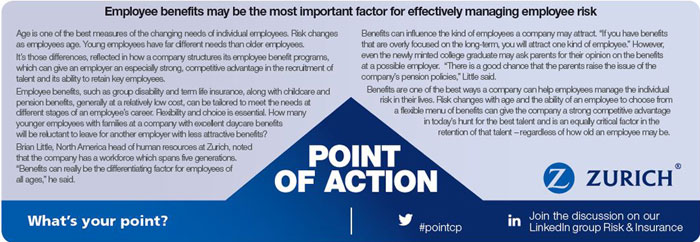Point/Counterpoint
Does an Aging Workforce Truly Represent Talent Risk for Today’s Employers?

Point: Older workers are more valuable than younger workers. Keep them as long as you can.
I reacted with wry amusement mixed with concern when a 20-something relation posted a picture of himself on Facebook the other day — taken by him at work — accompanied by a message saying that he had nothing to do at work.

Dan Reynolds, Editor-in-Chief, Risk & Insurance®
Need I say more?
I will say more because this is an example of someone who is so green that he didn’t stop to think about the implications of what he was doing.
With age, generally speaking, comes wisdom. Many times we don’t get things right on the first try. It can take years until we finally get a concept right.
As we grow, we learn and if we are not learning as we grow we are doing something wrong.
So why is it that we quietly usher out the door, never to return, the knowledge and experience of older workers, when someone reaches the age of 65 or 68?
There is a lot of value in older workers that as a culture we just let drop when we shouldn’t.
The fact that many workers these days need to work longer because they haven’t been able to save enough should not be looked at as a tragedy. It should be looked at as an opportunity. An optimist looks at the current economic cycle and sees tremendous value in keeping older workers on longer, when their knowledge is needed most.
Companies have the resources to make sure these older workers stay healthy and productive longer. Coaching on diet and exercise is just one of those resources.
Rather than look at older workers and younger workers as rivals, we should be looking at them as partners. The old can teach the young what they know about life and business. Younger workers can help older workers leverage their knowledge by using technology.
Let’s keep our older workers as long as we can. If we lose them we run the risk of knowledge drain, not to mention the loss of the talent we saw in them when we hired them in the first place.
If we retain them, that human asset, managed correctly, gains in value every year.
Counterpoint: Older workers are costing employers due to health factors and the exclusion of younger workers.
It may sound crass — and done improperly, it’s certainly the basis for a major class-action lawsuit — but companies really should be thinking more about “out with the old and in with the new.”

Anne Freedman, Senior Editor, Risk & Insurance®
Study after study has shown that older workers are putting off retirement, fearful of outliving their savings. It’s hard to blame them for that, but the down side for organizations is not just a decline of spark and creativity, it’s an increase in workplace absence and workers’ compensation costs.
According to the U.S. Centers for Disease Control, the amount of time off from work due to injury and illness increases steadily with age, even though the rate of injury and illness is similar for older and younger workers.
With the fastest growing segment of the working population being individuals 55 and older, the impact on organizations can be excessive. In this belt-tightening economy, can employers really afford those ever-growing expenditures?
The number of older workers still on the payroll is costing organizations in other ways as well — especially in the realm of lost innovation and opportunity. Young ideas, untethered to a philosophy of the same-old way of doing business, are what’s needed to jump-start many organizations.
In addition, young workers have an innate understanding of innovative technology, learned from the cradle and probably surpassing that of many organizations. That knowledge is crucial to putting together a successful vision and growth strategy.
By comparison, some older workers have difficulty in adapting to change and cutting-edge technology. And, let’s face it, many older workers have stopped trying so hard. They are competent, but comfortable. They are not looking to drive themselves hard at this stage of life.
There is no shortage of talented, younger employees in this struggling economy. In fact, according to a Northeastern University professor who recently crunched the numbers, about 36 percent of recent college graduates are mal-employed.
They are wasting their educations working in low-paid service industries. And their ambition and innovative ideas are being lost to employers, whose own workforces are stagnant.
Editor’s note: The opinions stated in the Zurich Point of Action are provided for informational purposes only and are solely those of Zurich in North America.
The Zurich Point of Action opinions are not legal advice and Zurich assumes no liability concerning the information above. The Point and Counterpoint opinions are those of Risk & Insurance® and are completely independent of Zurich.











